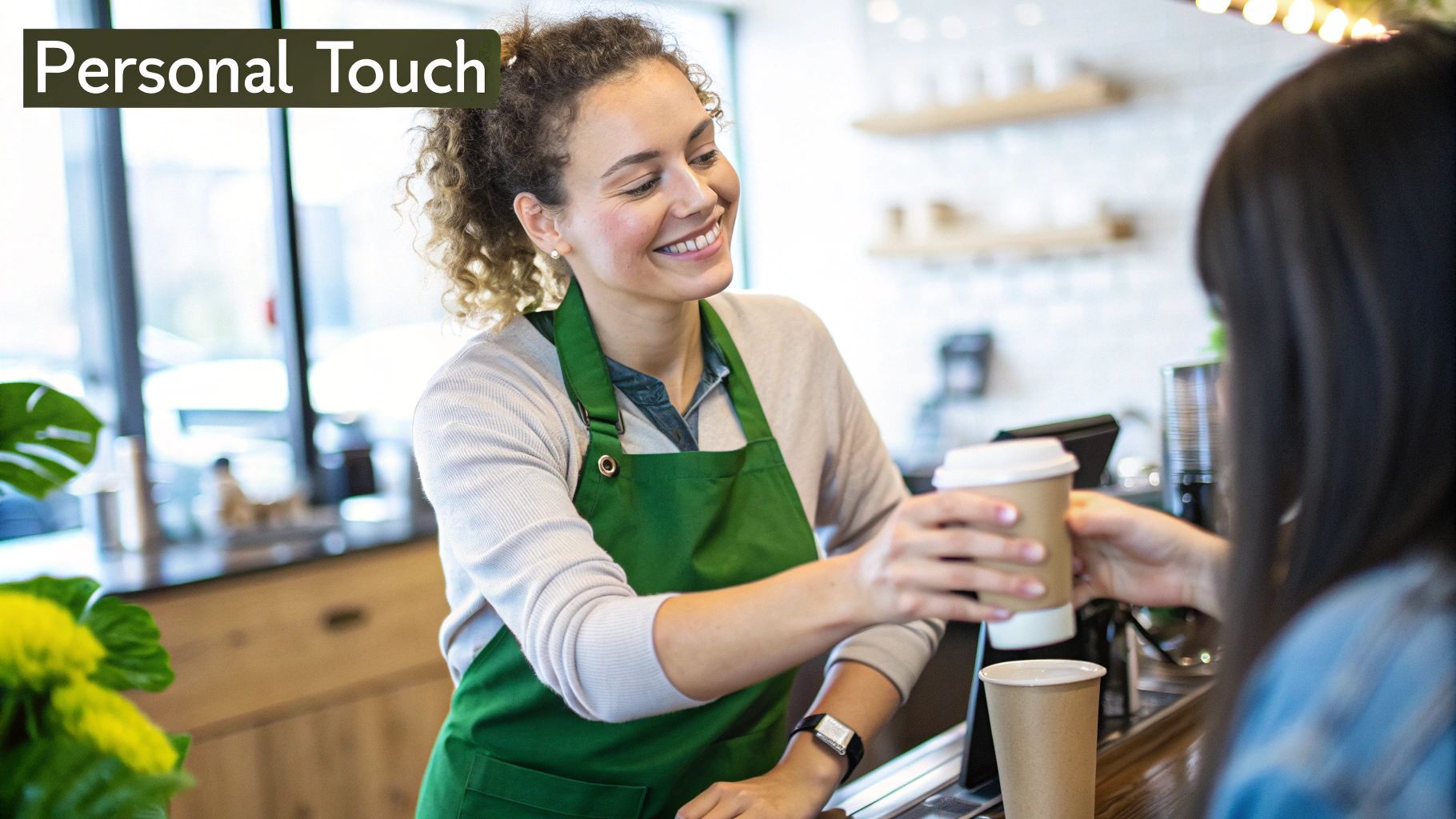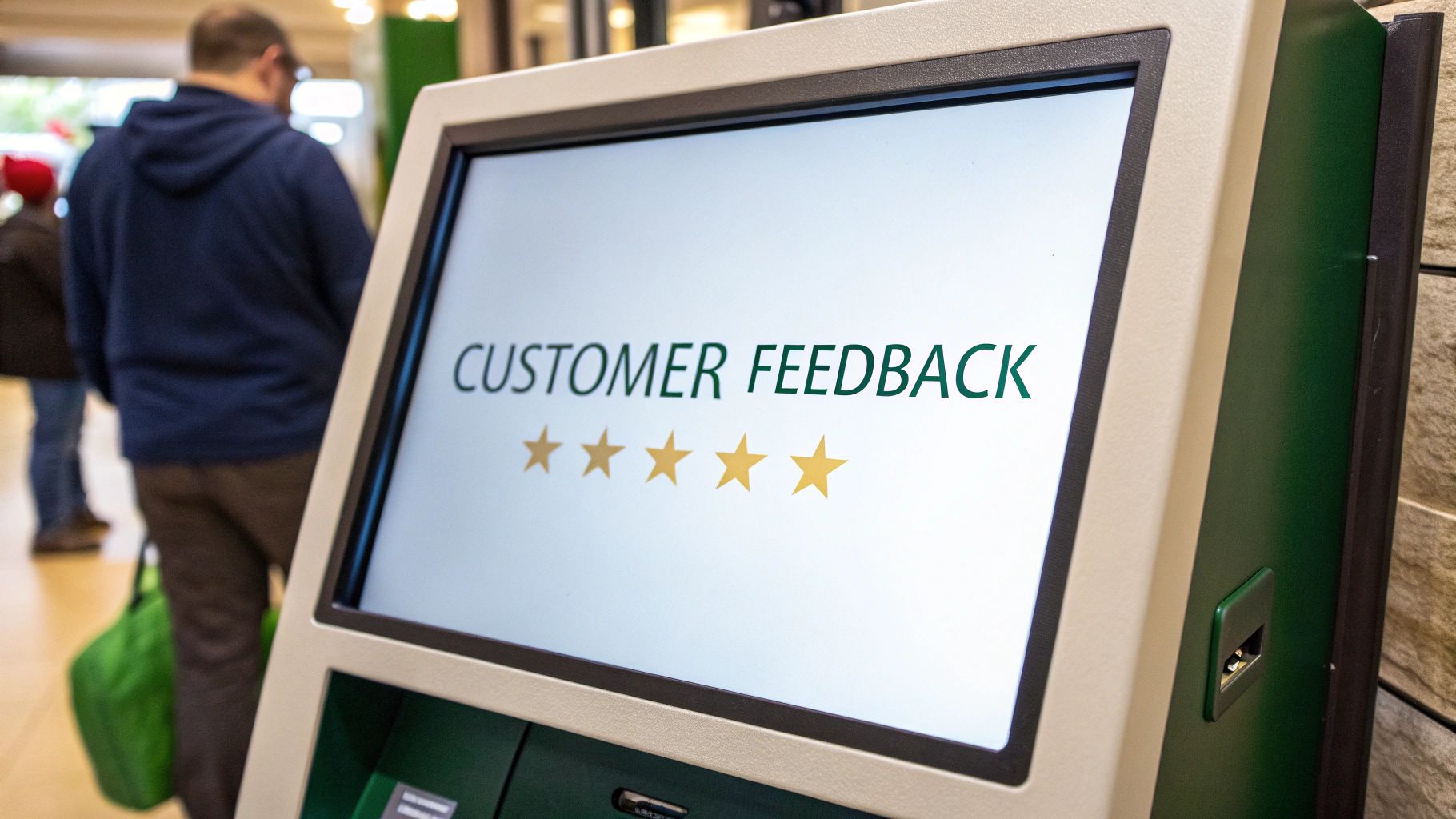Building genuine customer loyalty is about more than just convincing someone to buy from you again. It’s about forging a real relationship that makes people feel seen and valued, not just like another number in a transaction. In a market flooded with options, that connection is the single most powerful asset you can build to keep customers coming back for the long haul. The real goal is to move beyond simple repeat purchases and turn customers into true brand advocates.
Why Customer Loyalty Is Your Greatest Asset

Let's get real for a moment—finding new customers is expensive, and it's only getting tougher. Customer acquisition costs have jumped by nearly 60% in just the last five years. For many businesses, that means losing around $29 for every new customer they manage to bring in.
At the same time, brand allegiance is on the decline. In 2024, only 69% of consumers said they were loyal to specific brands, a significant drop from 77% just two years earlier. You can dig into more of these loyalty trends over at emarsys.com.
This economic reality makes one thing crystal clear: building a loyal customer base isn't just a nice-to-have; it's a financial lifeline. To truly unlock the power of this asset, you need to implement effective strategies to improve customer satisfaction and retention.
Core Pillars of Modern Customer Loyalty
In the past, a simple points card might have been enough to keep customers around. Those days are gone. Today’s customers expect much more from the brands they support; they're looking for authenticity and a real sense of connection. I've found that a modern, resilient loyalty strategy really boils down to three core pillars.
The table below breaks down these foundational elements. Understanding these pillars is the first step toward building a loyalty program that doesn't just offer discounts, but creates genuine brand advocates.
These pillars aren't just buzzwords; they represent a fundamental shift in how we should approach customer relationships. They guide you from a purely transactional mindset to a relational one.
The goal is to shift from a transactional mindset to a relational one. A loyal customer isn't just someone who buys from you; they are a partner in your brand's journey who feels seen, heard, and appreciated.
Building these kinds of connections takes a thoughtful, strategic approach. It all starts with a solid foundation, which is why I highly recommend checking out our guide on https://www.textla.com/post/how-to-build-a-winning-customer-communication-strategy.
Now, let's get into the practical, step-by-step process for turning these pillars into actionable SMS campaigns that will foster the lasting loyalty your business needs.
Know Your Customers Better Than They Know Themselves

You can't build loyalty with strangers. It's that simple. The real secret to making customers feel seen and valued is getting under the hood of their behaviors—not just glancing at their basic demographics. Forget generic assumptions and start digging into the data you already have, like purchase history and engagement patterns.
This data is an absolute goldmine for figuring out who your customers really are. By analyzing it, you can ditch the one-size-fits-all approach and start creating experiences that genuinely connect on a personal level. The objective here is to group customers into meaningful segments based on what they actually do.
Uncover Your Key Customer Segments
Start by identifying the distinct groups that make up your customer base. This doesn't have to be some complex data science project; it’s about spotting practical, real-world patterns.
For instance, a small e-commerce boutique could easily identify segments like:
- Weekend Shoppers: Customers who consistently buy things on Saturdays or Sundays.
- High-Value Heroes: The top 10% of spenders over the last six months.
- At-Risk Regulars: Loyal customers who haven't bought anything in over 90 days.
- New Potentials: First-time buyers who grabbed one of your best-selling items.
Once you have these segments defined, you can tailor your texts with incredible precision. A targeted message to your "At-Risk Regulars" with a special "we miss you" offer is lightyears more effective than a generic blast sent to everyone. This level of detail is a complete game-changer for building customer loyalty.
Don't just collect data—use it to tell a story about your customers. Each segment represents a different relationship with your brand, and each requires a unique conversation to nurture it.
This personalized approach is what makes customers feel understood, strengthening their bond with your brand. For small businesses ready to jump in, using an intuitive platform makes all the difference. You can find some fantastic tips for getting started with small business texting that align perfectly with this strategy.
Ultimately, knowing your customers on this deeper level is the bedrock of any loyalty program that actually works. It transforms your marketing from shouting at a crowd to having a meaningful, one-on-one conversation that builds lasting trust and keeps people coming back.
Create Personalized Experiences They Won't Forget

Generic, one-size-fits-all marketing just doesn't cut it anymore, especially when you're trying to build real customer loyalty. It’s a dead end. Once you have a handle on your customer segments, you can start crafting personal touches that make people feel genuinely seen and appreciated, not just like another number on a marketing list. This is where the real connection begins.
Authenticity is your most powerful tool here. A simple, relevant message that speaks directly to a customer’s actual experience with your brand will always outperform a complex, impersonal blast. The goal isn’t to be flashy; it’s to be thoughtful.
Go Beyond the First Name
True personalization digs way deeper than just dropping a {{first_name}} tag into a template. It's about reflecting a customer's unique journey with your brand. Think about the stories your data can tell, and use those insights to create small moments of delight.
Here are a few practical ideas you can put into action right away:
- Celebrate Milestones: Send a quick text to a customer on their one-year "purchase anniversary." Thank them for their support and maybe include a small, exclusive perk.
- Tailor Product Suggestions: Did someone from your "High-Value Heroes" segment recently buy a new coffee machine? A month later, ping them with a special offer on your new single-origin espresso beans. It just makes sense.
- Recognize Their Interests: If you know a customer consistently buys your running shoes, give them a heads-up when a new model is about to drop. They'll appreciate the inside track.
This targeted approach shows you're actually paying attention. It shifts the dynamic from a simple transaction to a valued relationship, which is the absolute cornerstone of building customer loyalty that lasts.
The most impactful personalized messages are the ones a customer didn't expect but immediately feel right. It’s the difference between saying "Hello, customer" and "Hey, we thought of you."
There's a reason businesses are pouring money into these strategies. The global loyalty management market ballooned from $3.65 billion in 2020 to $5.57 billion in 2022. It's projected to hit a staggering $24.44 billion by 2029.
This explosive growth is being driven by companies focusing on creating integrated customer journeys, with 62% deploying AI to make these interactions more meaningful. You can dive deeper into the loyalty management statistics that highlight this massive trend.
Using smart tools to scale these interactions is crucial. It allows you to deliver these personal moments consistently without ever losing that essential human touch.
Design a Loyalty Program with Real Value
 Let's be real: another generic points card just isn't going to cut it anymore. If you want to build genuine customer loyalty, your program has to offer something people actually want. The real secret is to think beyond simple discounts and create rewards that make your customers feel like part of an exclusive community.
Let's be real: another generic points card just isn't going to cut it anymore. If you want to build genuine customer loyalty, your program has to offer something people actually want. The real secret is to think beyond simple discounts and create rewards that make your customers feel like part of an exclusive community.
A well-designed program is a powerful retention engine, but it only works if the benefits feel tangible and valuable. The proof is in the numbers. The global loyalty management market is projected to explode from $13.31 billion in 2024 to over $41.2 billion by 2032.
This massive growth shows just how seriously brands are investing in structured programs. But you have to know your audience. In saturated markets like the UK, participation can be lukewarm, while it's booming in emerging markets like Brazil. You can dive deeper into these customer loyalty predictions and trends to see what’s on the horizon.
Choose a Model That Fits Your Brand
The structure of your program needs to feel authentic to your business. A simple, straightforward points-based system is a classic for a reason—it’s easy to understand. For every dollar spent, customers earn points they can cash in for a future reward. This is a great fit for businesses with frequent, smaller purchases, like a coffee shop or a fast-casual spot.
If you're trying to cultivate a more exclusive vibe, a tiered program is a fantastic option. Customers unlock better and better benefits as they spend more, which gives them a clear and motivating path to a higher status.
The best loyalty programs make customers feel like insiders. The goal is to reward behavior in a way that strengthens their emotional connection to your brand, not just their wallet.
Think about offering non-discount rewards that forge a much stronger bond. Here are a few ideas I've seen work wonders:
- Early Product Access: Give your most dedicated customers the first crack at new arrivals. A simple SMS with a private link can make them feel incredibly special.
- Exclusive Content: Offer members-only access to behind-the-scenes videos, expert tutorials, or articles that aren't available to the general public.
- VIP Event Invitations: Invite your top-tier members to a special online workshop or an in-person gathering. Nothing builds community like a shared experience.
These kinds of perks show you value their loyalty for more than just their repeat business. It’s how you shift the dynamic from purely transactional to truly relational—which is the entire point when you're figuring out how to build customer loyalty that lasts.
Turn Customer Feedback into Your Secret Weapon
Your customers are constantly giving you a direct roadmap to their loyalty—if you know how to listen. Too many brands treat feedback as a one-way street, but it’s so much more than that. Building a powerful feedback loop is one of the best ways to earn unbreakable trust and show people you genuinely care about their experience.
This isn't about just sending a survey and collecting data. It's about making feedback a core, active part of your relationship with your customers.
Listening is where it starts, but the real magic happens when you act on what you hear and—this is the crucial part—tell your customers about it. This simple practice is often called closing the feedback loop, and it’s a total game-changer for loyalty.
From Problem to Loyalty Win
Let's walk through a real-world scenario. Imagine a clothing brand gets several similar complaints via SMS and social media. The stitching on a popular new jacket just isn't holding up.
Instead of sweeping the issue under the rug, the company immediately halts production. They fix the design flaw. Then, they reach out directly to every single customer who took the time to point out the problem.
A simple, powerful SMS message could look like this:
"Hi, Alex. You told us the stitching on our new jacket wasn't up to par, and you were right. We've updated the design based on your feedback. As a thank you, here’s a code for a free replacement and 30% off your next order. We couldn't improve without you."
This one text does so much more than just fix a mistake. It validates the customer's opinion, shows you're actually listening, and turns a potential brand detractor into a vocal advocate. You’ve just transformed a negative experience into a positive story about a brand that truly cares.
This is a core part of closing the feedback loop to build customer loyalty. By making customers a part of your improvement process, you give them a real stake in your brand’s success. They feel heard, valued, and invested.
For more ideas on how to set up these listening posts, check out our detailed guide on how to collect customer feedback.
Answering Your Key Customer Loyalty Questions
As you start mapping out your loyalty strategy, a few common questions always seem to pop up. It's totally normal. Getting a solid handle on these core ideas is the first step to building a plan that actually works and feels right for your brand.
Let's dig into some of the most frequent questions we hear from businesses just like yours.
Loyalty vs. Retention: What's the Real Difference?
It’s tempting to use these terms interchangeably, but they represent two completely different kinds of customer relationships. Nailing this distinction is critical if you want to build something that lasts.
Here’s the simplest way to think about it: retention is transactional, while loyalty is emotional.
Retention just means a customer keeps buying from you. It could be out of habit, convenience, or maybe because they just don't know of a better option. They’re sticking around for now, but their business is always up for grabs.
Loyalty, on the other hand, is a conscious choice. It's when a customer chooses you over the competition, even when other options are available. They feel a real connection to your brand, they trust you, and they're the ones who will actively recommend you to their friends. Our goal is always to nudge customers from simple retention into true, enthusiastic loyalty.
A retained customer is one who continues to buy. A loyal customer is one who couldn't imagine buying from anyone else. The difference is the heart of your brand's long-term health.
Can Small Businesses Actually Compete?
Without a doubt. In fact, small businesses have a secret weapon against the big-box giants: the power of the personal touch. You probably can't compete on rock-bottom prices, so don't even try. Compete on the experience.
Your size and agility are your greatest strengths. Things like a handwritten thank-you note in a package, remembering a customer's last order, or a quick, personal reply to a social media comment can forge a bond that a massive corporation's generic points program never will.
Focus on creating a genuine sense of community and connection. That’s where you’ll win.
How Do I Know If My Loyalty Efforts Are Working?
You have to look beyond just repeat sales. To get a true picture of how your loyalty strategy is performing, you need to track a few key metrics that tell a much deeper story.
- Customer Lifetime Value (CLV): For your most dedicated customer segments, this number should be on a steady upward climb.
- Net Promoter Score (NPS): This is a direct measure of how many customers are willing to stick their neck out and recommend you. It's a fantastic gauge of advocacy.
- Repeat Purchase Rate: Keep an eye on how frequently your best customers are coming back for more.
A successful program will show that customers aren't just buying more often, but they're also spending more with you over time. That’s the real sign of success.
Ready to turn these insights into action? Textla provides the tools you need to create personalized, automated SMS campaigns that build real connections and foster lasting loyalty. Start building your loyal community today.

